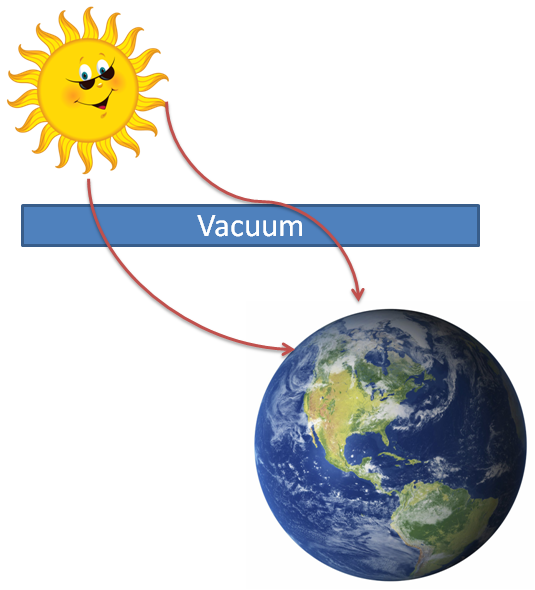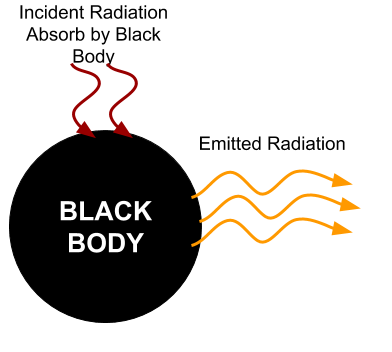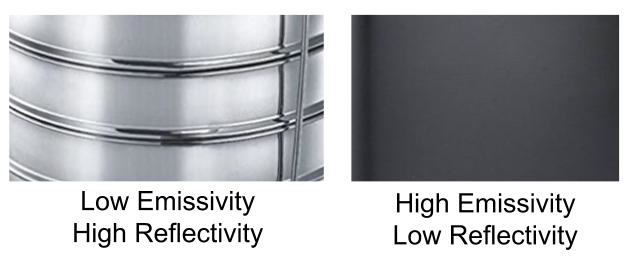What is Radiation Heat Transfer ?
Radiation heat transfer is the transfer of heat from one body to another body in the form of electromagnetic waves. Most of these radiations lie in the infrared region.
Unlike Conduction and Convection, radiation heat does not require any medium. All objects above absolute zero temperature emit radiation energy. Don’t miss this article on how does contactless Infrared Thermometer Works?

Any media between heat transfer bodies can absorb electromagnetic waves. Therefore Radiation Heat is more efficient in a vacuum.
An example of radiation heat is the heat transfer from the sun to earth due to electromagnetic waves through vacuum space. But when the sun radiation enters the earth’s atmosphere, its impact starts reducing due to air, gas, water, and dust particles present in the earth’s atmosphere.
All objects (solid, liquid, or gas) emit electromagnetic radiation because of thermal agitation inside their molecules. The rate of heat flux emitted by a body depends on body temperature and type of surface (color/finish etc.)
Heat Transfer by Radiation Examples
Following are the examples of radiation heat transfer:
- Heat transfer from the sun to the earth.
- Room heating radiators.
- The heat from incandescent lamps or fireplaces.
- Cooking food in the microwave.
- In the greenhouse effect, radiation from the sun comes through the glass to the plants.
- Measure human skin temperature using Infrared thermometers.
Radiation heat Transfer Equation : Stefan-Boltzmann Law
Stefan-Boltzmann’s Law of thermal radiation states that the rate of radiation heat transfer per unit area in a black body is directly proportional to the fourth power of the body temperature.
But in reality, a perfect black body does not exist. Therefore emissivity coefficient is used to consider this impact.
Radiation Heat Transfer = ε σ T⁴ A
T = absolute temperature in Kelvin
A = area of the emitting body in square meter
ε = emissivity coefficient of the body
σ = Stefan Boltzmann Constant = 5.6703 x 10⁸ W/m² K⁴
What is a Black Body ?
A Black body absorbs all electromagnetic radiation in all frequency ranges falling on it. In thermal equilibrium, the black body emits all the radiation. Therefore the black body is a perfect radiator.

But in the real world, black bodies do not exist. Real bodies emit radiation at a much lower rate than black bodies. In other words, real bodies are not perfect emitters. Therefore emissivity (ε) is used to include the impact of real surfaces on radiation emission. Emissivity for the black body is “one”.
What is Emissivity?
Emissivity defines a material’s ability to emit absorbed energy and returns to its normal temperature.
Mathematically emissivity is equal to the ratio of the emission from a real surface to the emission from a perfectly black surface at the same temperature and wavelength. The Emissivity value for a body varies from 0 to 1. For example, Human skin has a high value of emissivity 0.98.

A perfect reflecting surfaces have zero emissivity, whereas a perfect emitter has an emissivity one. A material emissivity depends on material and surface properties.
Reflective surfaces such as polished glass have a low emissivity. Whereas rough and oxidized material surfaces have high emissivity.
Emissivity Table
| Material | Temperature | Emissivity (For Refrence Only) |
| Human Skin | - | 0.98 |
| Polished Aluminum | 100 | 0.095 |
| Oxidized Aluminum | 200 | 0.11 |
| Ceramic Reflectory Black | 93 | 0.93 |
| Ceramic Reflectory White | 93 | 0.90 |
| Concrete | -- | 0.94 |
Radiation Heat Transfer Calculator
You can use this calculator to calculate the rate of radiation heat if body surface area, temperature, and emissivity values are known.
To sum up, Radiation-heat-transfer in grey bodies depends on outside temperature, Body temperature, and surface finish. The higher the value of emissivity, higher will be the rate of heat transfer. Don’t miss this article on various modes of heat transfer.

Add a Comment